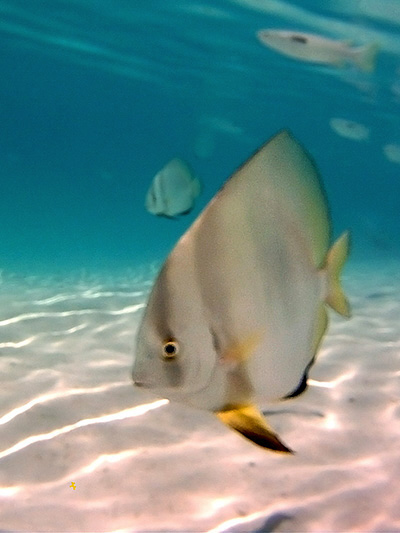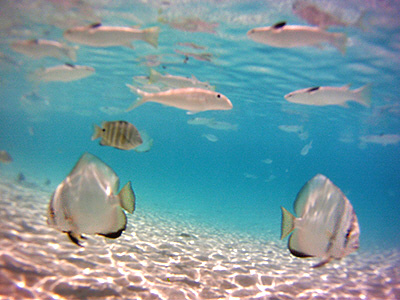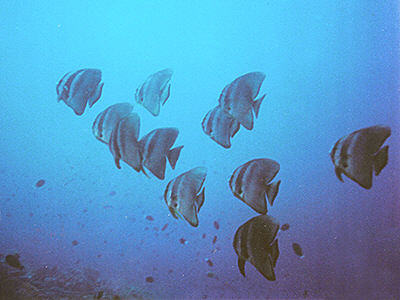
Fig 1

Fig 2

Fig 3
|
Order :
Perciformes
Family : EPHIPPIDAE
Species : 5 species recognised (as of 2019)
Maximum Length : up to 50-70 cm
Platax are a small group of laterally-compressed marine fishes in
the family Ephippidae. They are generally called 'batfish' (although the
name also applies to other type of fish), and they occur in a broad
geographic area, ranging from eastern Africa and the Red Sea through the Indian Ocean and the
Southeast Asia archipelago to the western Pacific Ocean.
The largest species appears to be the Long-finned Batfish (Platax teira), which
reaches between 60 and 70 cm long.
As of 2019, five species are recognised all of which have a
flattened, plate-like body shape, large dorsal and anal fins, and relatively
small tail fins. They are typically silvery, patterned with light to dark grey,
broad, vertical bars, one of which passes through the eye. The pectoral fins
may be yellowish or blackish, depending on the species.
Juveniles are typically orange or brownish with extremely long
dorsal, anal and pelvic fins.
Platax typically inhabit coral reefs and lagoons: adults tend to occur in
open, deeper waters, whilst juveniles tend to shelter closer to shore, or in
fringing mangrove. In Singapore, juvenile Platax are sometimes
observed amongst beds of seagrass, as well as boat jetties and reefs (Ria
Tan, 2016).
Juveniles of Platax orbicularis have been observed by day drifting on
the water's surface whilst mimicking fallen leaves and at the same time
feeding on algae growing on floating detritus, such as logs and other
debris. (Barros et al, 2008). At night juveniles assume typical swimming
behaviour, whilst feeding on planktonic food particles.
Figs 1 and 2 : A pair of Platax batfish, probably the
Orbicular Batfish Platax orbicularis, in a shallow lagoon at Bora
Bora, French Polynesia in the central Pacific Ocean.
Fig 3 : A shoal of 11 batfish at Walindi, Kimbe Bay, New Britain, Papua New
Guinea.
References :
Barros, B., Sakai, Y., Hashimoto, H. & Gushima, K. (2008). Feeding behavior
of leaf-like juveniles of the round batfish Platax orbicularis
(Ephippidae) on reefs of Kuchierabu-jima Island, southern Japan. Journal of
Ethology, 26(2), 287-293.
Links
Fishbase
- Ephippidae
Wild Singapore: batfishes factsheet
|